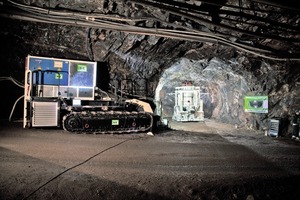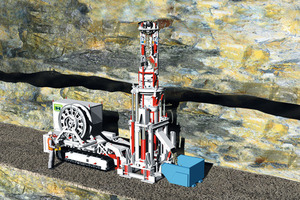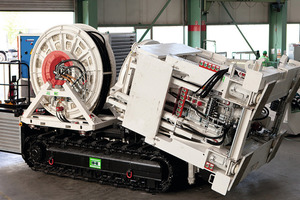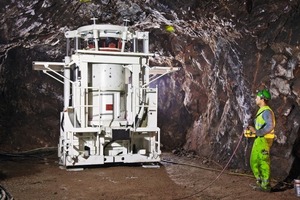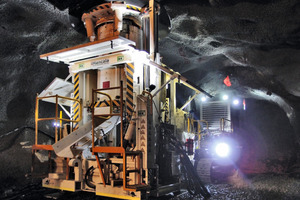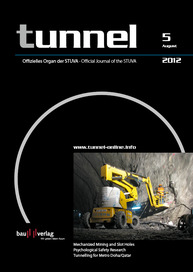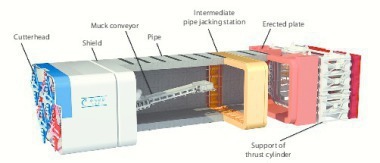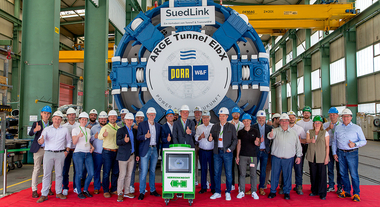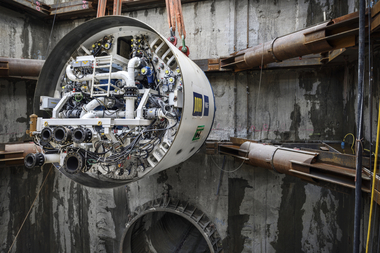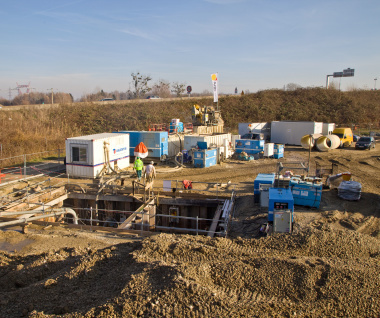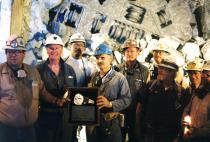New Technology
for Creating
Slot Holes
A large number of vertical or inclined small-diameter slot holes need to be excavated in many underground mines worldwide. To this aim, Herrenknecht has developed and built a new Boxhole Boring Machine (BBM) (Fig. 1). Its concept is based on the well-proven Microtunnelling pipe jacking technology – an area in which the company can look back on 25 years of experience in international projects.
1 Introduction
With this new BBM technology the target is a higher safety standard and minimal drift dimension. Higher production rates can be achieved using the Herrenknecht BBM resulting in significant time savings in producing slot holes compared to conventional drill and blast excavations. The faster and more safely slot holes can be constructed, the earlier the actual production in the mine can start or be continued.
Today, the BBM is primarily deployed in gold, copper and other ore mines usually prepared in accordance with the block caving method, whereby the BBM largely contributes toward preparing the draw points (ore extraction points) during the production process. Other applications include drilling ventilation shafts or preparing ore passes for transporting ore between the production level and the haulage level.
Initial results of the BBM indicate that the machine is capable of achieving high and consistent production rates and guarantees high mobility and flexibility compared to other methods.
2 The BBM concept
The Boxhole Boring Machine was developed for fast and safe construction of vertical and inclined slot holes (±30° from vertical) with a diameter of up to 1.5 m and a length of max. 60 m in hard rock formations. During development, the design was focused mainly on increased safety due to a remote operated machine, higher productivity and optimum machine mobility. Quick relocation of the BBM and minimum space requirements were also key factors of the design.
For transporting the BBM between different locations in the underground, a compact crawler unit provides fast transport and a high degree of flexibility in confined underground conditions. A modular design allows operation even in tight spatial conditions. The jacking frame with the boring unit, cable drum and power pack can be positioned separately.
The boring unit is positioned in the jacking frame during the transport. In the production area, the jacking frame is adjusted to its correct position and aligned toward the requisite boring angle. To stabilize the system and transfer the operational thrust and torque loads into the rock, the jacking frame is braced against the floor and the back (Fig. 2). Complex foundations can therefore be dispensed with as well as other preparatory excavation work on the back. The thrust forces are transferred from the jacking frame to the machine cutterhead via steel thrust pipes similar to a conventional horizontal pipe jacking operation. The cutterhead is designed for hard rock geologies of 180 MPa and more and fitted with multiple-row carbide cutters. Different cutterhead variants equipped with various cutter tools, e.g. single-disc cutters can also be used as an alternative.
A funnel on the boring machine below the cutterhead directs the excavated cuttings through the boring machine and the thrust pipes to the material chute on the jacking frame where they slide by gravity into a skip for transporting. Depending on the mine requirements, adapted solutions for further muck handling are also conceivable here.
After each meter of exaction, the operation process will be stopped temporarily and a clamping system holds the pipe string and the boring machine in place in order to install and connect the next thrust pipe. A wheel loader is used for installation. A breakout unit allows the thrust pipes to rotate ± 10° if the pipe string is blocked. This mechanism is integrated in the jacking frame.
Once the required boring depth has been reached, the boring unit is retracted. The thrust pipes are removed one by one from the bottom of the pipe string until the boring unit is completely pulled back through the drilled hole and is back in the jacking frame. After that, the BBM can be transported to the next site.
The Boxhole Boring Machine is fully remote-controlled. The crawler for relocating the BBM is also remote-controlled. The operator remains in a safe working area while the machine or crawler is in operation as well as during boring and transport.
3 Field test in the Black Forest
After assembly of the BBM1100 prototype in early 2011, it was tested under real conditions. The „Clara Mine“, a small mine site in the Black Forest close to the Herrenknecht factory (southern Germany) owned by Sachtleben Bergbau GmbH & Co. KG, presented optimum conditions for a field test. Over a period of 4 weeks, a number of detailed test slot holes were successfully drilled (Fig. 3).
Vertical and inclined test slot holes with a diameter of 1.1 m and a length of 9 m were successfully drilled and production rates of 9.0 m within 5 hours could be achieved in challenging rock conditions with a UCS of up to 250 MPa (Fig. 4). Instantaneous advance rates of 80 to 100 mm/min were achieved. During the test period, valuable data was collected in order to optimize operational parameters and handling details under real site conditions.
4 BBM goes Down Under – Application in the Cadia East Underground Project
After the successful test phase, the BBM was shipped to its destination – the “Cadia East Underground Mine” in New South Wales, 260 km west of Sydney, Australia. East of the Cadia East Underground Mine, gold and copper is produced in the open-pit mine at Cadia Hill. Extensive soil analyses have established additional ore deposits. Newcrest Mining Limited, a leading developer and operator of gold and copper mines, excavates these ore deposits at Cadia and started to excavate the raw material reserves at Cadia East in 2005. Ore deposits cover an area approx. 2.5 km in length, 600 m wide and up to 1.9 km deep. These ore reserves are estimated as harboring approx. 19 million ounces of gold and 3 million t of copper making Cadia East the largest underground mine in Australia and the deepest block caving underground mine in the world with a life time of around 30 years.
Preparations are fully underway for excavating the ore deposits with production scheduled to commence in 2013. The BBM is currently deployed at the production level for developing the draw points making it a key component in development of the mine.
Mancala Pty Ltd., a privately-owned group of companies providing specialized design, engineering, construction and excavation services for the Australian mining and construction industry, ordered a Herrenknecht BBM1100 in October 2010. After transportation and commissioning in Australia in September 2011, the BBM was transported to Cadia East. During the test run and commissioning at a depth of approx. 700 m, 3 vertical test operations with a length of approx. 18 m were successfully bored in fractured and blocky rock formations with a UCS of up to 200 MPa (Fig. 5).
The BBM1100 has been in operation at a depth of approx. 1000 m at the Cadia East production level since November 2011 where it plays a major role in constructing draw points for the subsequent production process.
To date, more than 40 slot holes (as at June 2012) have been produced with an average length of 16.5 m and an average advance rate of 1.5 m/h. The operator has succeeded in realizing up to 3 slot holes a week in single-shift operation (incl. setup, boring and transport preparation) thereby offering the mine operator and contractor security in terms of further planning.
5 Conclusion and outlook
The Boxhole Boring Machine (BBM1100) has been successfully used under real site conditions in the Cadia East Underground Project in Australia. To date more than 40 slot holes have been drilled with a high performance level.
The BBM technology offered by Herrenknecht represents an alternative concept for mines, planners and contractors to previous methods of producing slot holes of various diameters and lengths. BBM technology can be individually adapted to the respective mine requirements making it suitable for use in practically any mine.
Thanks to the positive results associated with increased work safety, mobility and independence of the plant, advance rate achieved in mining operations, service and ongoing development and improvement of the product during its initial operation in Australia, 3 further Boxhole Boring Machines are under manufacturing. These involve 2 identical BBM1100 machines for deployment in mines in Australia and a further development of the BBM1500 (steerable) model for the Chilean market where the BBM1500 will be used for producing slot holes with a length of 60 m and a diameter of 1,500 mm for various applications.
Acknowledgments
The authors would like to acknowledge the great support provided by the team of the Sachtleben Bergbau GmbH & Co. KG Clara Mine during the prototype testing period.

